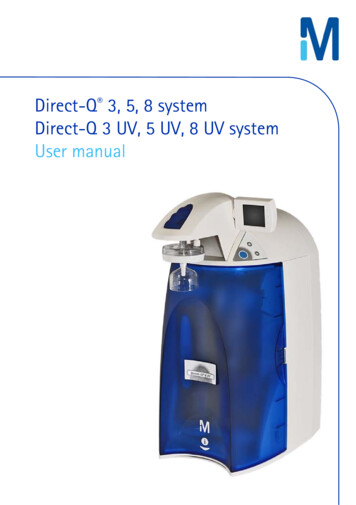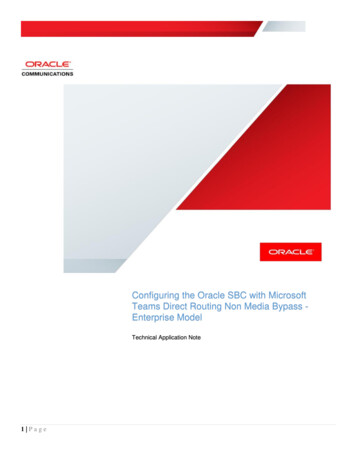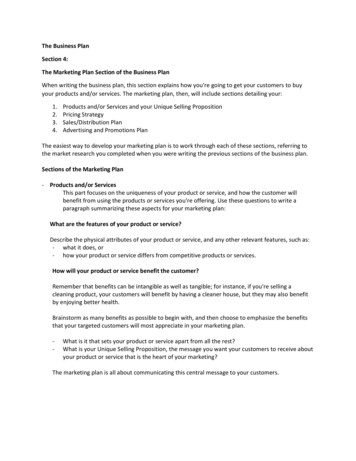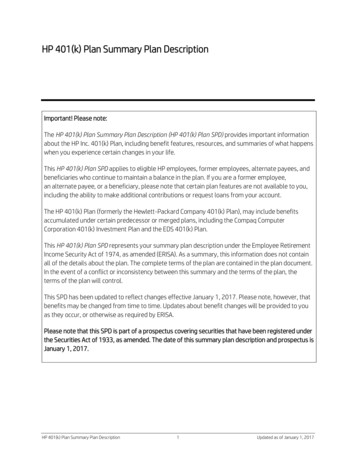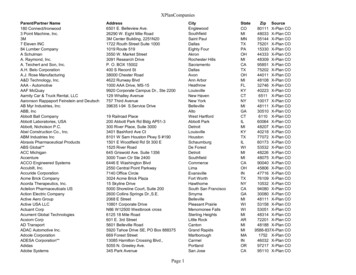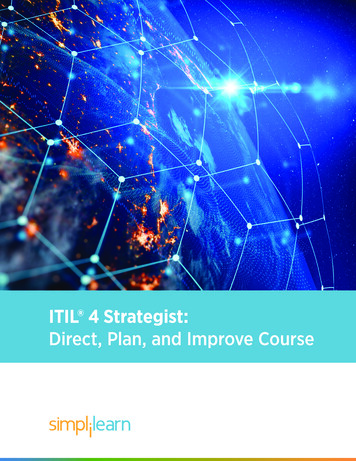
Transcription
ITIL 4 Strategist:Direct, Plan, and Improve Course
Table of Contents:Program OverviewKey Learning OutcomesProgram FeaturesCertification Details and CriteriaDelivery ModeCourse CurriculumPrerequisitesCustomer ReviewsTarget AudienceAbout UsProgram Overview:In this ITIL 4 Strategist: Direct, Plan, and Improve course you will learn the practical skillsneeded to create a “learning and improving” IT organization with a reliable and effectivestrategic direction. This ITIL 4 Strategist training program will help you understandthe impact of agile and lean work processes and how they can be leveraged to anorganization’s advantage.Program Features:7 hours of online self-paced learningExam fee included2 simulation exams20 PDUs for self-paced learningDelivery Mode:Online self-learningPrerequisites:To be eligible for this ITIL Strategist training, applicants should have:Passed the ITIL 4 Foundation examinationAttended an accredited training course for this module
Target Audience:This ITIL Strategist course is aimed at IT leaders and managers at all organizational levelswho are pursuing either the ITIL Managing Professional (MP) or ITIL Strategic Leader (SL)designation or those involved in shaping IT direction and strategy. It is also well-suited forthe following professionals:ITSM managersITSM practitioners managing IT-enabled products and servicesExisting ITIL qualification holders wishing to expand their knowledgeKey Learning Outcomes:When you complete this ITIL 4 Strategist: Direct, Plan, and Improve course, you willunderstand:How to use practical, strategic methods to plan and deliver continual improvement with thenecessary agilityThe impact of agile and lean ways of working, and how they can be leveraged to anorganization's advantageCertification Details and Criteria:Complete the online self-learning courseComplete the course-end assessment with a minimum 80% score
Course Curriculum:Lesson 01 - Course Introduction1.01 ITIL 4 Strategist Direct Plan and ImproveLesson 02 - Key Concepts of DPI2.01 Key Concepts of Direct, Plan, and Improve (DPI)2.02 Direction2.03 Policies and Guidelines2.04 Risks and Controls2.05 Planning2.06 Improvement2.07 Governance, Compliance, and Management2.08 Applying the Guiding Principles2.09 Operational Model2.10 Value, Outcomes, Costs, and Risks2.11 Key TakeawaysLesson 03 - Key Principles and Methodsof Direction and Planning3.01 Key Principles and Methods of Direction and Planning3.02 Strategy and Cascading Goals and Requirements3.03 Define Effective Policies, Controls, and Guidelines3.04 Effective Controls3.05 Effective Guidelines3.06 Decision Making at the Right Level3.07 Key TakeawaysLesson 04 - Governance, Risk, and Compliance4.01 Governance, Risk, and Compliance4.02 Structures and Methods for Decision Making4.03 Governance of Service Provider4.04 Role of Risk Management4.05 Key Takeaways
Lesson 05 - Continual Improvement5.01 Continual Improvement5.02 Continual Improvement Culture5.03 Continual Improvement in Organization5.04 The Continual Improvement Model5.05 Step One: What Is the Vision?5.06 Step Two: Where Are We Now?5.07 Step Three: Where Do We Want to Be?5.08 Step Four: How Do We Get There?5.09 Creating an Action Plan5.10 Step Five: Take Action?5.11 Step Six: Did We Get There?5.12 Step Seven: How Do We Keep the Momentum Going?5.13 Measurement and Reporting in Continual Improvement5.14 Assessments5.15 Gap Analysis5.16 SWOT Analysis5.17 Change Readiness Analysis5.18 Customer or User Satisfaction Analysis5.19 SLA Achievement Analysis5.20 Benchmarking5.21 Maturity Assessment5.22 Business Case5.23 Building a Business Case5.24 Communicating and Advocating for a Business Case5.25 Key TakeawaysLesson 06 - Communication andOrganizational Change Management6.01 Communication and Organizational Change Management6.02 Communications Principles6.03 Communication Is a Two-Way Process6.04 We Communicate All the Time6.05 Timing and Frequency Matter6.06 No Single Method of Communication Works for Everyone6.07 The Message Is in the Medium
6.08 Communication Methods and Media6.09 Examples of Communication Methods6.10 Defining and Establishing Feedback Channels6.11 Identifying and Communicating with Stakeholders6.12 Stakeholder Mapping6.13 Understanding Stakeholders6.14 Basics of Organizational Change Management (OCM)6.15 Essentials for Successful Improvement6.16 OCM Throughout Direction, Planning, and Improvement6.17 Establishing Effective Interfaces across the Value Chain6.18 Key TakeawaysLesson 07 - Measurement and Reporting7.01 Measurement and Reporting7.02 Basics of Measurement and Reporting7.03 Key Concepts of Measurement and Reporting7.04 Defining and Using Measurement and Reporting7.05 Reasons for Measuring7.06 Types of Measurement7.07 Relationship between Measurement and Behavior7.08 Measurement Cascades and Hierarchies7.09 Balanced Scorecard7.10 Success Factors and KPIs7.11 Key TakeawaysLesson 08 - Value Streams and Practices8.01 Value Streams and Practices8.02 Value Stream Mapping8.03 Developing a Value Stream Map8.04 Types of Waste8.05 Increasing the Detail in Value Stream Maps8.06 Measurement and the Four Dimensions
8.07 Measurement of Partners and Suppliers8.08 Measurement of Value Stream and Processes8.09 Process Metrics8.10 Value Stream and Processes in the SVS8.11 Relationship between Value Streams and Practices8.12 Relationship between Value Streams and Processes8.13 Designing a Workflow8.14 Workflow Metrics8.15 Key Takeaways
About Us:Simplilearn is the world’s #1 online bootcamp provider that enables learners throughrigorous and highly specialized training. We focus on emerging technologies and processesthat are transforming the digital world, at a fraction of the cost and time as traditionalapproaches. Over one million professionals and 2000 corporate training organizations haveharnessed our award-winning programs to achieve their career and business goals.For more information,please visit our website: ication-training-coursesimplilearn.comSimplilearn is the world's #1 online bootcamp for digital economy skills training focused on helping peopleacquire the skills they need to thrive in the digital economy.We provide rigorous online training in disciplines such as Cyber Security, Cloud Computing, ProjectManagement, Digital Marketing, and Data Science, among others. In other words, we specialize in areaswhere technologies and best practices are changing rapidly, and the demand for qualified candidatessignificantly exceeds supply.Based in San Francisco, California, and Bangalore, India, we have helped over one million professionals, andcompanies across 150 countries get trained, acquire certifications, and upskill their employees.Our award-winning online bootcamps are designed and updated by 2000 renowned industry andacademic experts. Through individual courses, comprehensive certification programs, and partnershipswith world-renowned universities, we provide millions of professionals and thousands of corporate trainingorganizations with the work-ready skills they need to excel in their careers. Our practical and appliedapproach has resulted in 85 percent of learners getting promotions or new jobs on day one. With over 1,000live classes each month, real-world projects, and more, professionals learn by doing at Simplilearn.India – United States – Singapore 2009-2020 - Simplilearn Solutions. All Rights Reserved.The certification names are the trademarks of their respective owners.
6.14 Basics of Organizational Change Management (OCM) 6.15 Essentials for Successful Improvement 6.16 OCM Throughout Direction, Planning, and Improvement 6.17 Establishing Effective Interfaces across the Value Chain 6.18 Key Takeaways Lesson 07 - Measurement and Reporting 7.01 Measurement and Reporting
